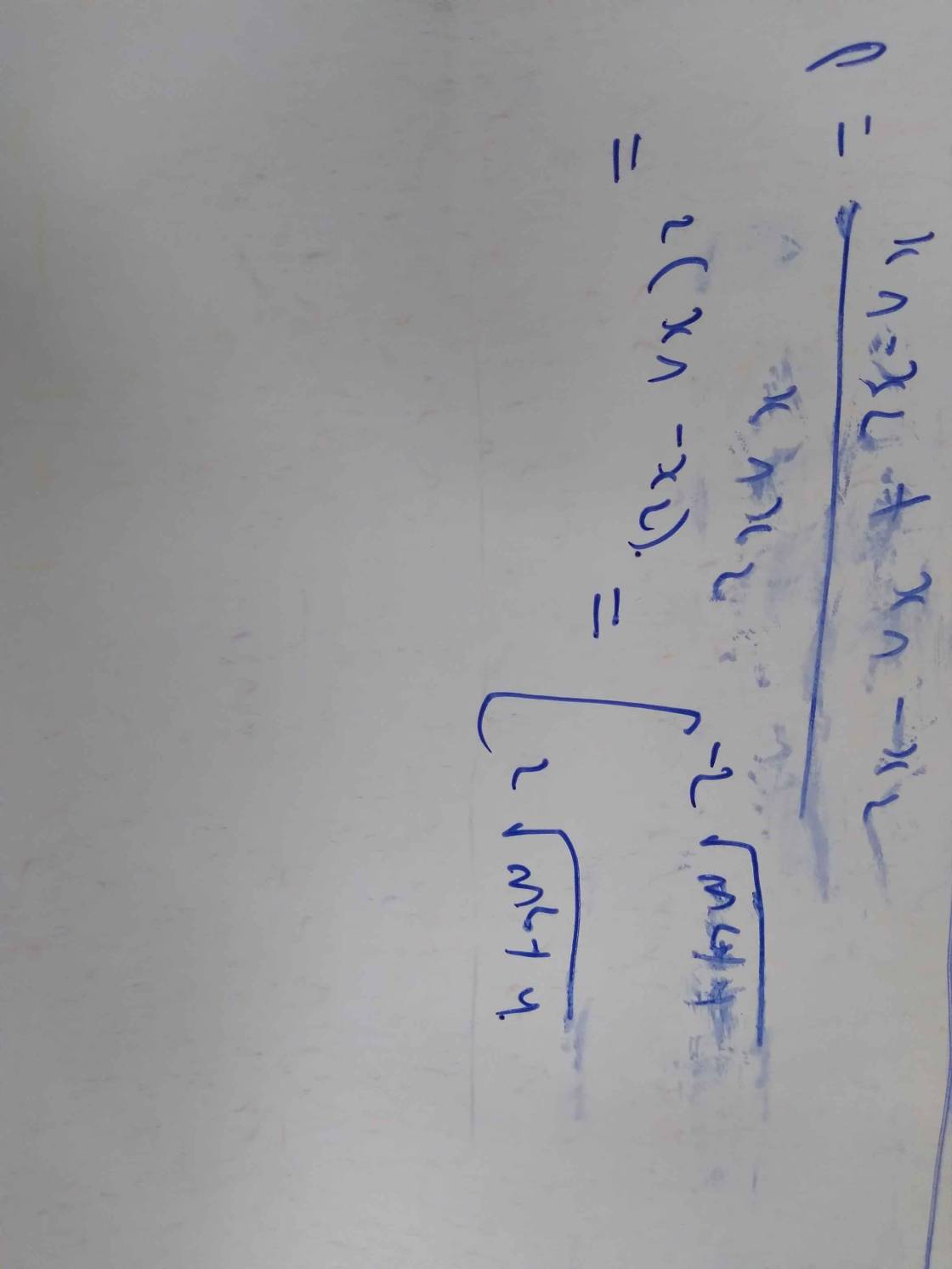Cho pt 4x^2 +3x-1 có 2 nghiệm x1,x2 ko giải pt tính giá trị biểu thức A= -2(x1-2)(x2-2)

Những câu hỏi liên quan
1. Cho pt 3x^2+4x+10có nghiệm x1,x2, không giải pt, hãy tính giá trị biểu thức Cdfrac{x_1}{x_2-1}+dfrac{x_2}{x_1-1}2. . Cho pt 3x^2-5x-10có nghiệm x1,x2, không giải pt, hãy tính giá trị biểu thức Ddfrac{x_1-x_2}{x_1}+dfrac{x_2-1}{x_2}3. . Cho pt 3x^2-7x-10có nghiệm x1,x2, không giải pt, hãy tính giá trị biểu thức Bdfrac{2x^2_2}{x_1+x_2}+2x_1
Đọc tiếp
1. Cho pt \(3x^2+4x+1=0\)
có nghiệm x1,x2, không giải pt, hãy tính giá trị biểu thức \(C=\dfrac{x_1}{x_2-1}+\dfrac{x_2}{x_1-1}\)
2. . Cho pt \(3x^2-5x-1=0\)
có nghiệm x1,x2, không giải pt, hãy tính giá trị biểu thức \(D=\dfrac{x_1-x_2}{x_1}+\dfrac{x_2-1}{x_2}\)
3. . Cho pt \(3x^2-7x-1=0\)
có nghiệm x1,x2, không giải pt, hãy tính giá trị biểu thức \(B=\dfrac{2x^2_2}{x_1+x_2}+2x_1\)
1. Theo hệ thức Vi-ét, ta có: \(\left\{{}\begin{matrix}x_1+x_2=-\dfrac{4}{3}\\x_1.x_2=\dfrac{1}{3}\end{matrix}\right.\)
\(C=\dfrac{x_1}{x_2-1}+\dfrac{x_2}{x_1-1}=\dfrac{x_1\left(x_1-1\right)+x_2\left(x_2-1\right)}{\left(x_1-1\right)\left(x_2-1\right)}\)
\(=\dfrac{x_1^2-x_1+x_2^2-x_2}{x_1x_2-x_1-x_2+1}=\dfrac{\left(x_1+x_2\right)^2-2x_1x_2-\left(x_1+x_2\right)}{x_1x_2-\left(x_1+x_2\right)+1}\)
\(=\dfrac{\left(-\dfrac{4}{3}\right)^2-2.\dfrac{1}{3}-\left(-\dfrac{4}{3}\right)}{\dfrac{1}{3}-\left(-\dfrac{4}{3}\right)+1}=\dfrac{\dfrac{22}{9}}{\dfrac{8}{3}}=\dfrac{11}{12}\)
Đúng 3
Bình luận (1)
\(1,3x^2+4x+1=0\)
Do pt có 2 nghiệm \(x_1,x_2\) nên theo đ/l Vi-ét ta có :
\(\left\{{}\begin{matrix}S=x_1+x_2=\dfrac{-b}{a}=-\dfrac{4}{3}\\P=x_1x_2=\dfrac{c}{a}=\dfrac{1}{3}\end{matrix}\right.\)
Ta có :
\(C=\dfrac{x_1}{x_2-1}+\dfrac{x_2}{x_1-1}\)
\(=\dfrac{x_1\left(x_1-1\right)+x_2\left(x_2-1\right)}{\left(x_2-1\right)\left(x_1-1\right)}\)
\(=\dfrac{x_1^2-x_1+x_2^2-x_2}{x_1x_2-x_2-x_1+1}\)
\(=\dfrac{\left(x_1^2+x_2^2\right)-\left(x_1+x_2\right)}{x_1x_2-\left(x_1+x_2\right)+1}\)
\(=\dfrac{S^2-2P-S}{P-S+1}\)
\(=\dfrac{\left(-\dfrac{4}{3}\right)^2-2.\dfrac{1}{3}-\left(-\dfrac{4}{3}\right)}{\dfrac{1}{3}-\left(-\dfrac{4}{3}\right)+1}\)
\(=\dfrac{11}{12}\)
Vậy \(C=\dfrac{11}{12}\)
Đúng 3
Bình luận (0)
\(3,3x^2-7x-1=0\)
Do pt có 2 nghiệm \(x_1,x_2\) nên theo đ/l Vi-ét ta có :
\(\left\{{}\begin{matrix}S=x_1+x_2=-\dfrac{b}{a}=\dfrac{7}{3}\\P=x_1x_2=\dfrac{c}{a}=-\dfrac{1}{3}\end{matrix}\right.\)
Ta có :
\(B=\dfrac{2x_2^2}{x_1+x_2}+2x_1\)
\(=\dfrac{2x_2^2+2x_1\left(x_1+x_2\right)}{x_1+x_2}\)
\(=\dfrac{2x_2^2+2x_1^2+2x_1x_2}{x_1+x_2}\)
\(=\dfrac{2\left(x_1^2+x_2^2\right)+2x_1x_2}{x_1+x_2}\)
\(=\dfrac{2\left(S^2-2P\right)+2P}{S}\)
\(=\dfrac{2\left(\dfrac{7}{3}^2-2\left(-\dfrac{1}{3}\right)\right)+2\left(-\dfrac{1}{3}\right)}{\dfrac{7}{3}}\)
\(=\dfrac{104}{21}\)
Vậy \(B=\dfrac{104}{21}\)
Đúng 3
Bình luận (4)
Xem thêm câu trả lời
cho pt x2-2(m+1)x+m-4=0
a, Giải pt khi m= -5
b, CMR pt luôn có nghiệm x1, x2 với mọi m
c, Tìm m để pt có 2 nghiệm trái dấu
d, Tìm m để pt có 2 nghiệm dương
e, CMR biểu thức A=x1(1-x2)+x2(1-x1) không phụ thuộc m
f, Tính giá trị của biểu thức x1-x2
CHo pt x-4x-3=0 có 2 nghiệm phân biệt x1,x2 không giải phương trình hãy tính giá trị của biểu thức A=\(\dfrac{x1^2}{x2}+\dfrac{x2^2}{x1}\)
\(x^2 - 4x - 3 = 0\) có 1.(-3) < 0
=> Phương trình có hai nghiệm phân biệt
Áp dụng hệ thức Vi-et có \(x_1 + x_2 = 4\) \(; x_1x_2 = -3\)
Mà \(A = \dfrac{x_1^2}{x_2} + \dfrac{x_2^2}{x_1}\)
\(= \dfrac{x_1^3 + x_2^3}{x_1x_2}\)
\(= \dfrac{(x_1 + x_2)(x_1^2 - x_1x_2 + x_2^2)}{x_1x_2}\)
\(=\dfrac{(x_1+x_2)[(x_1 +x_2)^2 - 3x_1x_2]}{x_1x_2}\)
\(=\dfrac{4.[4^2 - 3.(-3)]}{-3}\)
\(= \dfrac{-100}{3}\)
Đúng 1
Bình luận (0)
Cho pt x^2-mx-1=0 a) chứng minh pt có 2 nghiệm trái dấu b) gọi x1,x2 là các nghiệm của pt 1 Tính giá trị của biểu thức P= x1^2+x1-1/x1 - x2^2+x2-1/x2
\(3x^2+4x+1=0\\ \) có 2 nghiệm x1, x2.
B= \(\dfrac{x^1}{x_2-1}+\dfrac{x^2}{x_1-1}\)
không giải PT, tính giá trị biểu thức B
Lời giải:
Áp dụng hệ thức Viet:
$x_1+x_2=\frac{-4}{3}; x_1x_2=\frac{1}{3}$
Khi đó:
\(B=\frac{x_1}{x_2-1}+\frac{x_2}{x_1-1}=\frac{x_1(x_1-1)+x_2(x_2-1)}{(x_1-1)(x_2-1)}\)
\(=\frac{x_1^2+x_2^2-(x_1+x_2)}{x_1x_2-(x_1+x_2)+1}=\frac{(x_1+x_2)^2-2x_1x_2-(x_1+x_2)}{x_1x_2-(x_1+x_2)+1}\)
\(=\frac{(\frac{-4}{3})^2-2.\frac{1}{3}-\frac{-4}{3}}{\frac{1}{3}-\frac{-4}{3}+1}=\frac{11}{12}\)
Đúng 2
Bình luận (0)
cho pt x^2-ax+1=0.giả sử pt có 2 nghiệm x1,x2.tính giá trị biểu thức S=x1^5+x2^5 theo a
Bài 1 cho pt x^2-2(m+1)x+4m+m^2=0 .Tìm m để phương trình có 2 nghiệm phân biệt x1,x2 sao cho biểu thức A =|x1-x2| đạt giá trị nhỏ nhất
bài 2 cho pt x^2+mx+2m-4=0.Tìm m để phương trình có 2 nghiệm phân biệt x1,x2 thỏa mãn |x1|+|x2|=3
bài 3 cho pt x^2-3x-m^2+1=0.tìm m để phương trình có 2 nghiệm phân biệt x1,x2 thỏa mãn |x1|+2|x2|=3
Cho pt 4x^2 - 3x -2=0 có 2 nghiệm x1 x2, không tìm x1 x2 hãy tính giá trị của A= (2x1+3)(2x1-3) - 6x - 3x2 +6
Cho pt 3x^2-2x-a=0
Không giải pt, tính giá trị biểu thức
A=(x1^2-5x1-2)(x2^2+5x1-2)+3(x1^2+x2^2)
























